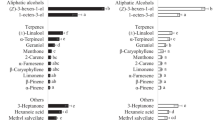Abstract
A comparison was made of the EAG responses of repleted males and females of Glossina palpalis gambiensis Vanderplank, G. tachinoides Westwood, G. fuscipes fuscipes Newstead, G. morsitans morsitans West wood and G. austeni Newstead to the odour of various concentrations of acetone, 4-heptanone, 3-nonanone and l-octen-3-ol. The stimulatory effectiveness of these substances increased in the order: acetone < 4-heptanone < 3-nonanone < 1-octen-3-ol. Amounts of acetone 103–104 times greater and of 4-heptanone and 3-nonanone 10–100 times greater than those of l-octen-3-ol were required to obtain similar EAG responses. These results are discussed in relation to the behavioural effects of the odours of these substances on tsetse in wind tunnel experiments in the laboratory and catching experiments in the field. In G. m. morsitans and G. tachinoides, the EAG responses of males were somewhat higher than those of females. In G. austeni, G. f. fuscipes and G. palpalis gambiensis, however, the reverse occurred. All species were equally tuned to the four odour substances, which indicates that these odours do not determine host specificity.
Résumé
Une étude comparative des réponses électroantennographiques des mâles et des femelles de Glossina palpalis gambiensis Vanderplank, G. tachinoides Westwood, G. fuscipes fuscipes Newstead, G. morsitans morsitans Westwood et G. austeni Newstead a été faite après engorgement à diverses concentrations d’acétone, 4-heptanone, 3-nonanone et l-octen-3-ol. Les effets stimulants de ces substances augmentent dans l’ordre: acétone < 4-heptanone < 3-nonanone < l-octen-3-ol. Les quantités d’acétone 103 à 104 fois plus élevées et de 4-heptanone et 3-nonanone 10 à 100 fois plus élevées que celles de l-octen-3-ol étaient requises pour obtenir les réponses électroantennographiques semblables. Ces résultats sont mis en relation d’affaires avec l’impact des odeurs de ces substances sur le comportement des mouches tsétsé dans le laboratoire et sur le terrain. Chez G. m. morsitans et G. tachinoides les réponses électroantennographiques des mâles étaient plus élevées que celles des femelles. Chez G. austeni, G. f. fuscipes et G. palpalis gambiensis les antennes des femelles étaient plus sensibles que celles des mâles. Toutes les espèces étaient également sensibles aux 4 substances odorantes, ce qui indique que ces odeurs ne déterminent pas de spécificité d’hôte.
Similar content being viewed by others
References
Brady J. (1972) The visual responsiveness of the tsetse fly Glossina morsitans Westw. (Glossinidae) to moving objects: the effects of hunger, sex, host odour and stimulus characteristics. Bull. ent. Res. 62, 257–279.
Bursell E. (1984) Effects of host odour on the behaviour of tsetse. Insect Sci. Applic. 5, 345–349.
Chorley T. W. (1948) Glossina pallidipes Austen attracted by the scent of cattle-dung and urine (Diptera). Proc. R. Ent. Soc., London 23, 9–11.
Den Otter C. J., Behan M. and Maes F. W. (1980) Single cell responses in female Pieris brassicae (Lepidoptera: Pieridae) to plant volatiles and conspecific egg odours. J. Insect Physiol 26, 465–472.
Den Otter C. J. and Saini R. K. (1985) Pheromone perception in the tsetse fly Glossina morsitans morsitans. Ent. exp. appl. 39, 155–161.
Den Otter C. J. and Thomas G. (1979) Olfactory preference in insects: A synthesis of behaviour and electrophysiology. In Preference Behaviour and Chemoreception (Edited by Kroeze J. H. A.), pp. 171–182. Information Retrieval Ltd., London.
Frezil J. L. and Carnevale P. (1976) Utilisation de la carboglace pour la capture de Glossina fuscipes quanzensis Pires 1948 avec le piège Challier-Laveissiere. Conséquences épidémiologiques. Cah. ORSTOM Sér. ent. méd. Parasit. 14, 225–233.
Hall D. R., Beevor P. S., Cork A., Nesbitt B. F. and Vale G. A. (1984) l-octen-3-ol. A potent olfactory stimulant and attractant for tsetse isolated from cattle odours. Insect Sci. Applic. 5, 335–339.
Hargrove J. W. and Vale G. A. (1978) The effect of host odour concentration on catches of tsetse flies (Glossinidae) and other Diptera in the field. Bull. ent. Res. 68, 607–612.
Owaga M. L. A. (1984) Preliminary observations on the efficacy of olfactory attractants derived from wild hosts of tsetse. Insect Sci. Applic. 5, 87–90.
Owaga M. L. A. (1985) Observations on the efficacy of buffalo urine as a potent olfactory attractant for Glossina pallidipes Austen. Insect Sci. Applic. 6, 561–566.
Turner D. A. (1971) Olfactory perception of live hosts and carbon dioxide by the tsetse fly Glossina morsitans orientalis Vanderplank. Bull. ent. Res. 61, 75–96.
Vale G. A. (1974) The responses of tsetse flies (Diptera, Glossinidae) to mobile and stationary baits. Bull. ent. Res. 64, 545–588.
Vale G. A. (1980) Field studies of the responses of tsetse flies (Glossinidae) and other Diptera to carbon dioxide, acetone and other chemicals. Bull. ent. Res. 70, 563–570.
Vale G. A. (1981) Prospects for using stationary baits to control and study populations of tsetse flies in Zimbabwe. Zimbabwe Sci. News 15, 181–186.
Vale G. A. (1982) Prospects for using stationary baits to control and study populations of tsetse flies (Diptera: Glossinidae) in Zimbabwe. In Sterile Insect Technique and Radiation in Insect Control. Internat. Atomic Energy Agency, Vienna, pp. 191–203.
Vale G. A. and Hall D. R. (1985) The role of l-octen-3-ol, acetone and carbon dioxide in the attraction of tsetse flies, Glossina spp. (Diptera: Glossinidae), to ox odour. Bull. ent. Res. 75, 209–217.
Van der Pers J. N. C. and Löfstedt C. (1986) Signal-response relationship in sex pheromone communication. In Mechanisms in Insect Olfaction (Edited by Payne T. L., Birch M. C. and Kennedy C. E. J.), pp. 235–241. Oxford University Press, New York.
Author information
Authors and Affiliations
Rights and permissions
About this article
Cite this article
Den Otter, C.J., Tchicaya, T. & Van den Berg, M.J. Olfactory Sensitivity of five Species of Tsetse (Glossina spp.) to l-Octen-3-ol, 4-Heptanone, 3-Nonanone and Acetone. Int J Trop Insect Sci 9, 213–218 (1988). https://doi.org/10.1017/S1742758400006007
Received:
Revised:
Published:
Issue Date:
DOI: https://doi.org/10.1017/S1742758400006007




